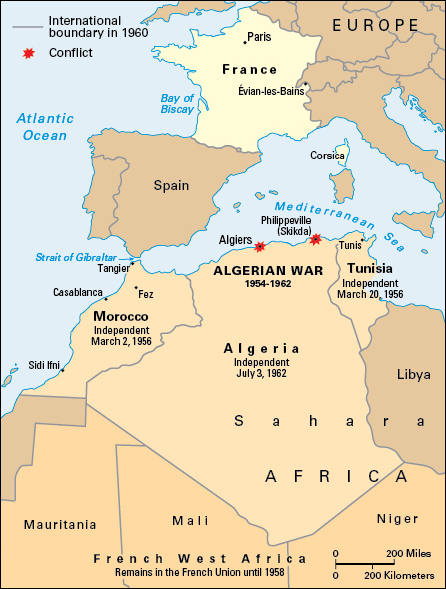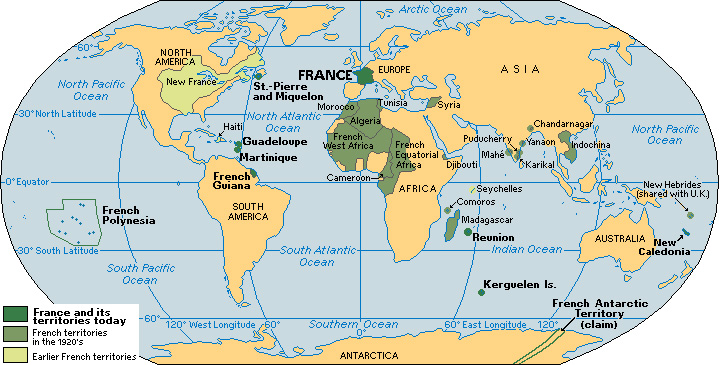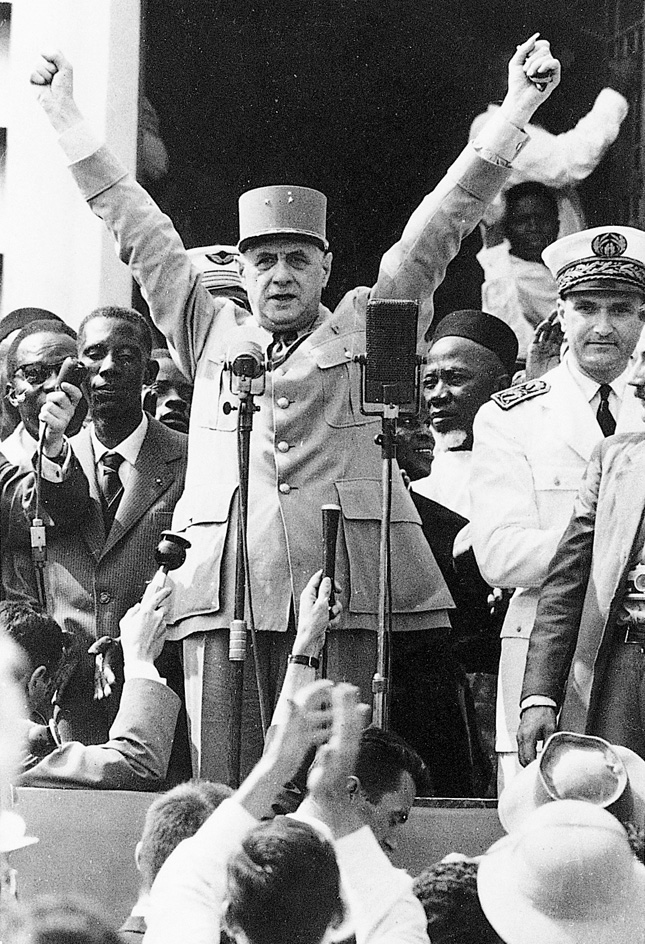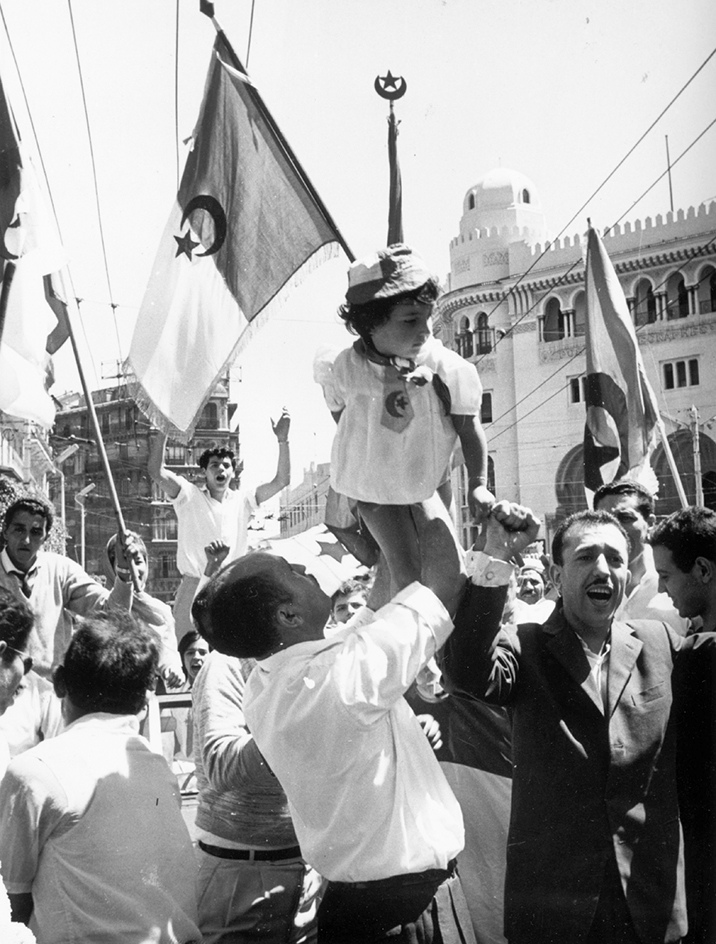
Algerian War was a conflict between Algerian and French forces from 1954 to 1962. Algeria, which had long been under French control, became independent as a result of the war. The Algerian War involved numerous acts of massacre, terrorism, and torture. Charles de Gaulle, a famous French soldier and statesman, returned from retirement to lead France during the conflict. In Algeria, the war is known as the War of National Liberation, or simply the Revolution.
Background.
In 1830, France invaded and colonized northern Algeria. In 1848, the colony became a French territory. France controlled all of what is now Algeria by 1914. 
Many French people and other Europeans settled in Algeria. Non-French Europeans in Algeria became French citizens, but France made it difficult for Algeria’s native Muslims to do the same. European settlers, given large amounts of land, soon controlled Algeria’s economy and government. Muslims, who made up about 90 percent of the population, remained largely poor. The French government and military resisted Muslim attempts to gain equality.
In the years following World War II (1939-1945), Algeria’s French colonial neighbors, Morocco and Tunisia, were nearing independence. A similar drive toward independence was taking place in French Indochina (present-day Cambodia, Laos, and Vietnam). A movement for Algerian independence also gained strength. However, European Algerians, called pied-noirs (French for black-feet), resisted economic, political, and social reform. 
In 1954, a number of Muslim Algerian political groups merged to form the National Liberation Front, or FLN (Front de Libération Nationale). The FLN wanted Algeria to be an independent Islamic state with no ties to France. The Algerians became encouraged by France’s defeat in Indochina (see Dien Bien Phu, Battle of). Feeling unable to reach its goals politically, the FLN planned for a war of liberation.
The war.
On Nov. 1, 1954, FLN forces attacked French military installations, police posts, and communication facilities throughout Algeria. The attacks enraged the French government. The French saw the rebellion as a treasonous act and considered the rebels terrorists. Determined to crush the revolt and preserve Algérie française (French Algeria), the French brought in tens of thousands of troops.
Algerian and French troops clashed in the Algerian countryside and along the Tunisian border. However, the FLN fighters were unable to challenge the strength of the French military in traditional battle. As a result, they resorted to guerrilla warfare, laying ambushes, planting bombs, and plotting assassinations. The FLN also targeted pied-noir civilians and Muslims suspected of French sympathies.
In August 1955, an FLN-incited mob massacred more than 120 pied-noirs in the northern port of Philippeville (now Skikda). The French government claimed it killed more than 1,200 FLN fighters in retaliation. According to the FLN, however, French retaliatory strikes killed more than 12,000 Muslims—both fighters and civilians. Massacres of both pied-noirs and Muslims became routine in the war. Public opinion soon shifted against the French, in part because of the harsh retaliations.
In September 1956, violence erupted in Algiers, Algeria’s capital and largest city. FLN bombs exploded in pied-noir cafés, bars, and stadiums. In January 1957, French paras (elite paratroopers) occupied Algiers, and FLN attacks quickly declined. The paras left Algiers in March, but new bombings forced their return. The paras gathered suspects on brutal campaigns that became known as ratonnades (rat hunts). The French tortured prisoners to gain information. The elimination of local FLN leaders quieted Algiers in September 1957. 
By early 1958, the French government faced economic troubles, social unrest, and public opposition to the war. That May, French military officers, fearing the abandonment of Algeria, seized power in Algiers. With the French government in crisis, statesman Charles de Gaulle returned to power. De Gaulle, who had led French resistance against Germany in World War II, had been in retirement since 1951.
De Gaulle soon restored order in France as well as in Algiers. He helped create a new French constitution, and he became president in December 1958. By that time, even though France had established clear military dominance in Algeria, public support for the war was declining. Attempts at negotiating a cease-fire failed, however, and the war continued.
In April 1961, frustrated French officers again tried to seize power in Algiers. The attempt failed, and a number of prominent officers were arrested. De Gaulle began negotiating with FLN leaders that May, but the talks dragged on for months. The violence continued. 
Some renegade French troops formed a group called the Secret Army Organization, or OAS (Organisation de l’armée secrète). The OAS killed anyone it considered a threat to French Algeria. In 1961 and 1962, the OAS killed more than 2,300 people in Algiers and other cities. Operating in France as well, the OAS made several failed attempts on de Gaulle’s life.
Finally, in March 1962, French and FLN representatives meeting at Évian-les-Bains, France, agreed to a cease-fire. The agreement, known as the Évian Accords, ended the Algerian War. For the next several months, loyal French troops acted as peacekeepers in Algeria. On July 3, Algeria became independent.
Aftermath.
French officials estimated that more than 240,000 Muslims died in the Algerian War. The FLN, however, claimed more than 1 million Muslim deaths. Many Muslims were killed by French troops and police, but many others died at the hands of the FLN. The FLN killed tens of thousands of Muslims who were suspected of working with the French. The FLN also killed members of competing Muslim political groups, both in Algeria and France.
About 18,000 French troops were killed in action, and another 65,000 were wounded. About 3,000 pied-noir civilians died. More than 1 million other pied-noirs left Algeria. Large numbers of pied-noirs and Muslim Algerians fled to France.
